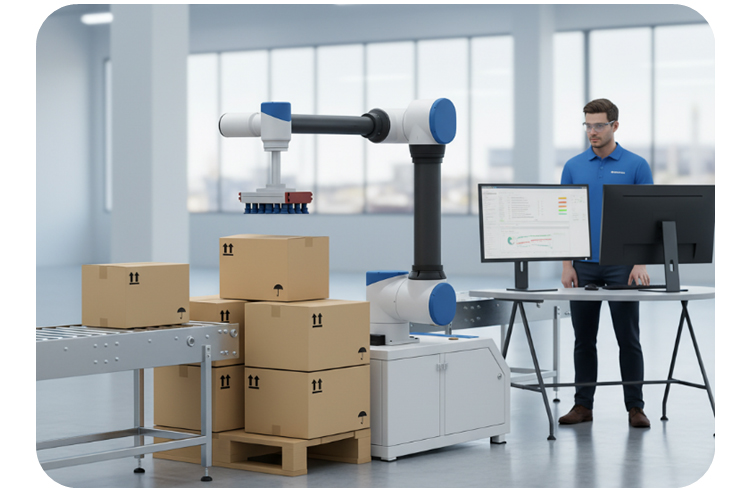
How to Deploy a Cobot Palletiser in Your Factory
Why Cobot Palletisers Are Transforming Australian Manufacturing
The Shift from Manual to Automated Palletising
For many years, palletising has been one of the most repetitive and labour-intensive stages in manufacturing. Manual stacking not only limits throughput but also increases the risk of fatigue and injury. As Australian manufacturers face ongoing labour shortages and rising operational costs, automation has become a key strategy for maintaining productivity and competitiveness.
Enter the Cobot Palletiser – a new generation of collaborative robots designed to safely work alongside people, reduce manual handling, and streamline end-of-line operations.
How Cobot Palletisers Differ from Traditional Robotic Systems
Traditional robotic palletisers are fast and powerful, but they often require safety fencing, complex programming, and larger footprints. In contrast, cobot palletisers use advanced sensors and torque control to operate safely without cages, making them ideal for space-constrained factories and multi-SKU operations.
They’re designed to be easy to program, quick to redeploy, and flexible enough to handle changing product mixes — perfect for small and medium-sized manufacturers.
Benefits for Small to Medium Manufacturers
A cobot palletiser offers immediate advantages:
• Significant labour savings by automating repetitive stacking tasks.
• Improved safety and compliance with modern workplace standards.
• Compact design suited to smaller factory layouts.
• Fast ROI, typically within 12–24 months.
For many manufacturers, cobots provide an accessible and scalable entry point into automation without the complexity of large-scale robotic systems.
Understanding What a Cobot Palletiser Can Do
Key Features and Capabilities
A Cobot Palletiser can handle boxes, cartons, bags, or pails up to a defined payload, stacking them precisely onto pallets using pre-set patterns. Modern systems feature:
• Touch-screen HMIs for easy recipe selection.
• Quick-change grippers for different product types.
• Adaptive reach and height capabilities for varying pallet sizes.
Safety and Collaboration in the Workplace
Cobots use advanced force sensors and speed monitoring to ensure safe interaction with nearby operators. They stop immediately upon contact and can be programmed to slow down when humans enter a shared workspace. This makes them ideal for collaborative environments where safety and flexibility are equally important.
Ideal Applications Across Different Industries
Cobot palletisers are increasingly used across food and beverage, personal care, pharmaceuticals, construction materials, and agricultural sectors. Any operation that places filled containers, cartons, or bottles onto pallets can benefit from the consistency and efficiency that cobots deliver.
Preparing Your Factory for a Cobot Palletiser
Assessing Your Current Palletising Process
Before deploying a cobot, it’s important to evaluate your current setup. Key questions include:
• How many pallets are built per shift?
• What products, sizes, and weights are being handled?
• How consistent are packaging formats and production rates?
This information forms the basis for selecting the right cobot and layout.
Space, Layout, and Safety Considerations
Although cobot palletisers require less floor space than traditional robots, layout still matters. The cobot must have enough reach to access pallets, conveyors, and product infeed points while maintaining ergonomic access for operators. Process Evolution assists clients in mapping ideal layouts and performing risk assessments to ensure compliance with AS/NZS 4024 safety standards.
Identifying the Right Product and Throughput Requirements
Each cobot has limits for payload, reach, and cycle speed. Understanding your required throughput — such as cartons per minute or pallets per hour — helps determine whether a cobot palletiser, dedicated palletising machine, or industrial robotic cell is the best fit.
The Step-by-Step Process to Deploy a Cobot Palletiser
Step 1 – Defining Objectives and ROI Targets
Start by clarifying your goals. Are you aiming to reduce labour costs, increase throughput, or improve safety? Establishing key performance indicators (KPIs) early ensures your investment aligns with measurable outcomes.
Step 2 – System Design and Layout Planning
Process Evolution’s team designs your system around the available floor space, product flow, and pallet configuration. This stage includes choosing the right gripper, conveyor interfaces, and safety systems.
Step 3 – Installation, Commissioning, and Testing
The cobot is installed and integrated into your existing line, followed by commissioning and performance testing. Every sequence, pattern, and safety function is verified to ensure smooth operation.
Step 4 – Operator Training and Handover
Unlike traditional automation, cobot palletisers are user-friendly. Operators are trained to create and modify stacking recipes using an intuitive interface, allowing your team to take ownership of day-to-day operation without reliance on external programmers.
Integrating a Cobot Palletiser into Your Production Line
Connecting with Upstream Case Pack and Conveyor Systems
For maximum efficiency, your cobot palletiser should integrate seamlessly with upstream equipment such as case packers, conveyors, or shrink wrappers. Automated communication ensures consistent product flow and minimal downtime.
Using Recipe-Based Programming for Multiple SKUs
With recipe-based programming, you can switch between product types at the press of a button. Each recipe defines stacking patterns, pallet dimensions, and gripper settings — ideal for contract manufacturers or brands managing multiple product lines.
Maintaining Flexibility and Uptime
Cobot systems can be redeployed or reconfigured as production changes. Process Evolution provides ongoing support, maintenance, and software updates to keep your system performing reliably for years.
Common Challenges and How to Avoid Them
Misjudging Throughput or Payload Requirements
One of the most common pitfalls is underestimating the required speed or payload. A detailed assessment with Process Evolution ensures the selected system matches your actual production rate and product mix.
Overlooking Product Stability and Packaging Variations
Different box weights and surfaces can affect stacking stability. Proper testing and gripper design are essential to maintain consistent, stable pallet loads.
Failing to Plan for Future Growth
A well-designed Cobot Palletiser system should be scalable. Choosing modular hardware and open-architecture controls allows for future expansion, new products, or integration with warehouse automation.
Why Work with a Local Automation Partner
Designed and Supported Locally for Australian Conditions
At Process Evolution, we design, assemble, and support our cobot palletising solutions here in Australia. Local expertise means faster turnaround, hands-on commissioning, and real-time support when you need it.
Compliance with AS/NZS 4024 Safety Standards
All our systems are designed to comply with Australian safety requirements. We perform full risk assessments and validation testing to ensure safe operation in every factory environment.
Ongoing Service, Support, and Spare Parts Availability
Our clients benefit from long-term partnerships — not one-off projects. With local spare parts, service technicians, and remote support options, downtime is minimised, and performance is maximised.
The ROI and Long-Term Value of a Cobot Palletiser
Labour Savings and Productivity Gains
Even one cobot can offset the equivalent of multiple manual operators. With reduced labour dependency and higher consistency, most systems achieve payback in under two years.
Safer Workplaces and Happier Teams
By removing the most physically demanding tasks, cobots improve workplace safety and morale. Operators can focus on quality, supervision, and higher-value tasks.
Building a Scalable and Future-Ready Operation
A Cobot Palletiser is more than a machine — it’s an investment in your future capability. It creates flexibility, reduces cost per pallet, and positions your factory to adapt as technology and customer demands evolve.
Conclusion: Simplifying Automation with Process Evolution
Deploying a Cobot Palletiser doesn’t have to be complex. With the right planning, design, and local support, it can be one of the easiest and most rewarding steps toward automation.
At Process Evolution, we combine engineering expertise with hands-on manufacturing experience to deliver flexible, compliant, and future-ready palletising systems for Australian manufacturers.
Talk to us today to explore how a Cobot Palletiser can transform your production line — safely, efficiently, and sustainably.

